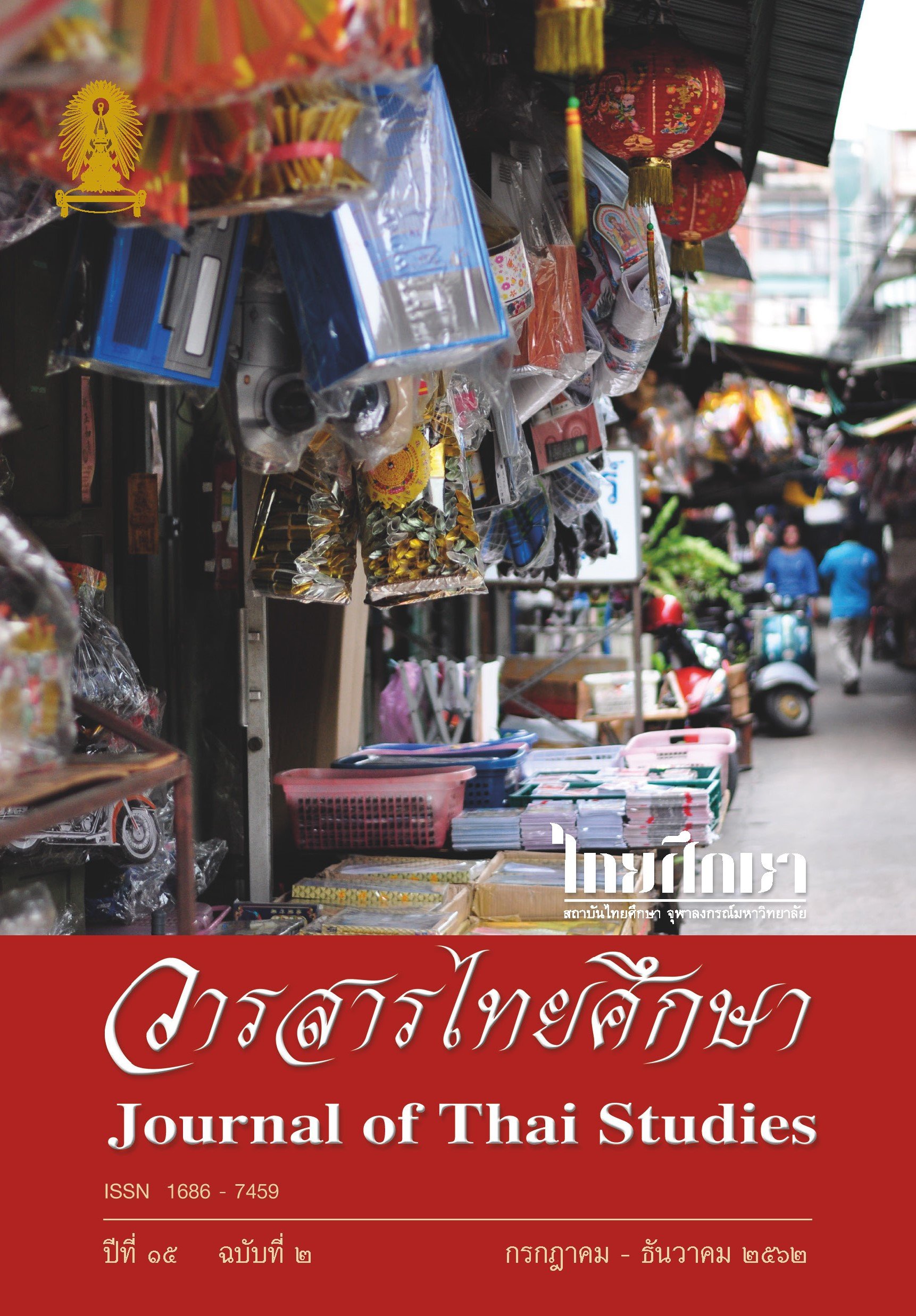Tortoise Cake Offering Rituals in Talad Noi, Bangkok and Bangneaw, Phuket
Main Article Content
Abstract
Hokkien shrines that were built over 100 years ago in Talad Noi, Bangkok and Bangneaw, Phuket are highly revered, especially by the local people of these communities. Every year these two shrines prepare specially-made tortoise cakes as offerings during important festivals, as Hokkiens have long believed that a tortoise is an auspicious animal symbolizing longevity, fortune and wealth, while possessing power to protect people from harm. However, the tortoise cakes made by these two communities are significantly different from the more common Hokkien-style red tortoise cakes seen elsewhere. The Talad Noi cakes are white in color and made from wheat flour, similar to Chinese steamed buns. Talad Noi locals make these primarily as ritual offerings during the Lantern Festival. Bangneaw’s tortoise cakes, on the other hand, are red in color, made of glutinous rice flour, and are mainly prepared as ritual offerings during the Ghost Festival. Both tortoise cake offering rituals reflect the cultural assimilation and continuity in these two communities as their respective beliefs and customs are passed on from generation to generation. However, interestingly, while some of these beliefs and customs have been perfectly preserved in their original forms, others have assimilated to the changing local cultures and social environments.
Downloads
Article Details

This work is licensed under a Creative Commons Attribution-NonCommercial-NoDerivatives 4.0 International License.
Journal of Thai studies is licensed under a Creative Commons Attribution-Noncommercial-NoDerivatives4.0 Intenational (CC BY-NC-ND 4.0) licence, unless otherwise stated. Plese read our Policies page for more information on Open Access, copyright and permissions.
References
Chaiyapotpanit, A. (2018). San chao chin nai Krungthep [Chinese shrines in Bangkok]. Bangkok: Matichon.
Chantrasorn, K. (1963). Itthiphon khong chao chin phonthale lae botbat khong khon chin nai prathet Thai samai patchuban [The influence of overseas Chinese and the role of overseas Chinese in Thailand at present time]. Bangkok: Odeon store.
Nonnat, A. (2016). Khanom tao nai thetsakan yuan siao thi san chao Chao Sue Kong Talat Noi [Tortoise cakes in Lantern festival at Chao Sue Kong shrine Talat Noi]. Retrieved from http://lek-prapai.org/home/view.php?id=5250
Ratchatapattanakul, N. (2003). Talat Noi phatthana kan chumchon chek nai Bangkok [“Talat noi” The development of Chinese communities in Bangkok]. Art and Culture magazine, 24(4), 162-165.
Sikakosol, T. (2014). Thetsakan chin lae kan sen wai [Chinese festivals and offering rituals]. Bangkok: Matichon.
Songprasert, P. (2004). Chin phonthale samaimai [New overseas Chinese]. Bangkok: Love and Lip Press.
Suksamran, S. (1987). Khwamchuea thang satsana lae phithikam khong chumchon chao chin [Religious beliefs and rituals among Chinese communities]. Bangkok: Dissemination of research work project, Division of Research, Chulalongkorn University
Disciples of “Pho To Kong” and others. (n.d.). Ruam prawat khong san chao seng tek beo bang niao phuket lae thima khong prapheni pho to bang niao [The history of Seng Tek Beo shrine and Pho To festival in Bang niao, Phuket]. n.p.
Chinese references
Ding, L. (2015). Quantai chonggui xisu yu wenhua jiaoliu [Turtle worshipping tradition and cultural exchange between Quanzhou and Taiwan]. The 6th cross-strait Minnan cultural symposium: A new exploration of Minnan culture, 570-574.
Du, Y and others. (2016). Qiantan Zhongguo gui wenhua yu Chaoshan chuantong cunluo [Discussion of Chinese turtle culture and Chaoshan traditional villages]. Beijing Planning Review, 3, 108-111.
Han, L. (2010). Hong guiguo zai Taiwan [Red turtle cakes in Taiwan]. Fujian-Taiwan Cultural Research, 22, 138-143.
Lin, C. (2015). Taiwan he Minnan de chonggui xisu [Turtle worshipping tradition in Taiwan and Minnan]. Folk Custom in China, 2, 31-34.
Liu, Z. (1997). Lun Zhongguo gui wenhua ji quzhe [Discussion of Chinese turtle culture and its distortion]. Root exploration, 6, 5-12.
Sheng, Y. (2012). Gui chongbai bianyi de yuanyin ji shehui jichu fenxi [Analysis of causes and social basis affecting the variation of the turtle worshipping tradition]. Qun Wen Tian Di, 9, 169-170.
Wei, X. (2014). Minnan guiguo yin de jixiang biaozheng [The auspicious symbols in patterns on turtle cakes in Minnan]. Folk Art and Culture, 12, 112-114.
Wei, X. (2018). Cong Minnan guiguo yin kan chonggui wenhua [Understanding turtle culture through patterns on Minnan turtle cakes]. Journal of Quanzhou Normal University, 36(3), 22-25.
Wu, J. (2015). Yinxiang wanqian: Guiguo yinmo de tu’an ji minsu yiyun [Profound Impression: The beauty of turtle cake patterns and the implications in folklore]. Art and Life - Journal of Fuzhou University, 3, 42-44.
Interviews
Katemanee, S. (2019, July 15). Personal Interview.
Koysiripong, P. (2019, July 19). Personal Interview.
Limnunthaphisit, D. (2019, July 19). Personal Interview.
Luangaroon, W. (2019, July 15). Personal Interview.
Preechakorn, P. (2019, July 20). Personal Interview.
Samanruangsak, C. (2019, July 15). Personal Interview.
Tongpinyochai, V. (2019, July 20). Personal Interview.


